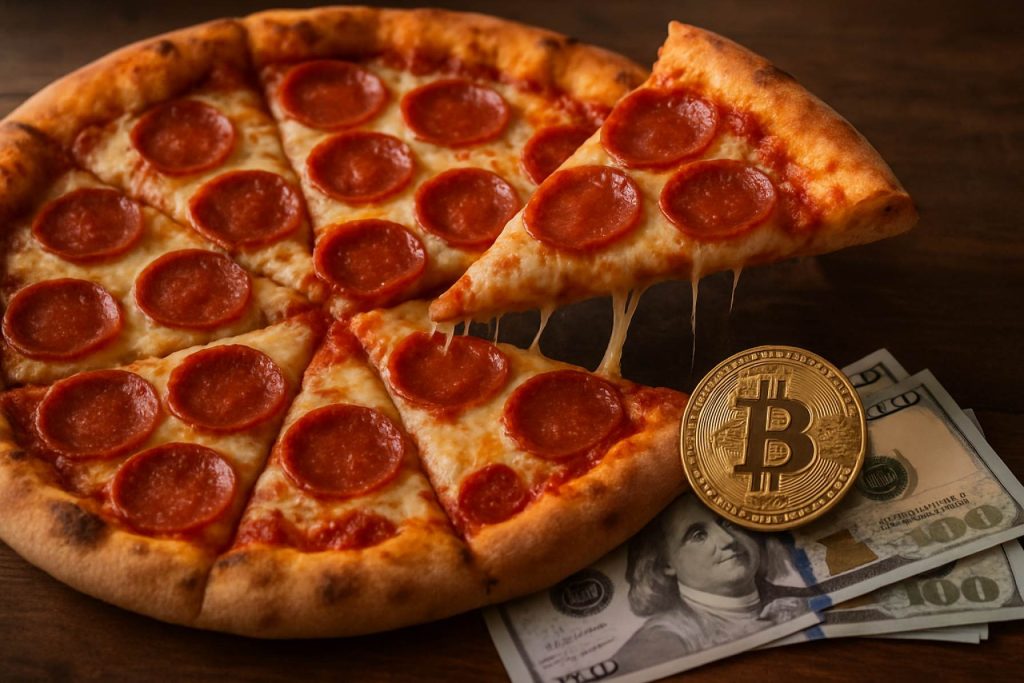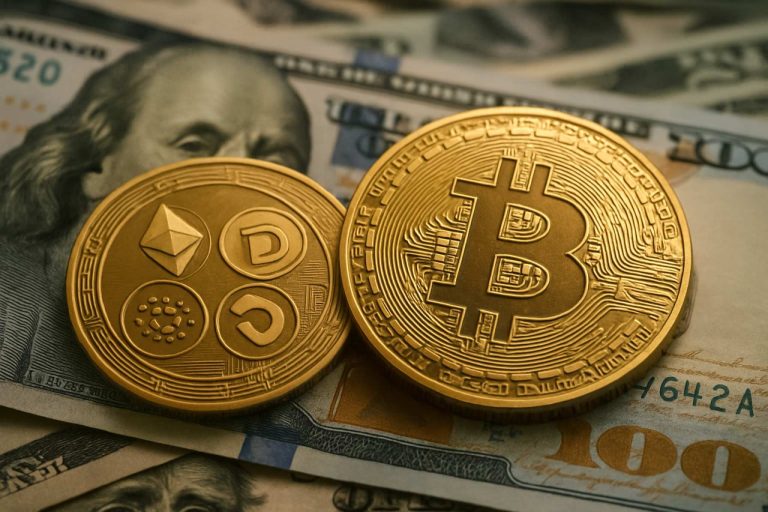
- Bitcoin Pizza Day marks the first real-world bitcoin transaction, where 10,000 BTC bought two pizzas, highlighting cryptocurrency’s leap from novelty to global financial force.
- The once modest purchase, now worth over $1.1 billion, symbolizes Bitcoin’s meteoric value rise and impact on modern finance.
- This event demonstrates how groundbreaking shifts can emerge from everyday actions and simple experiments.
- Bitcoin’s journey since that transaction includes the rise of crypto exchanges, widespread economic debate, and integration into mainstream financial systems.
- Bitcoin Pizza Day remains a reminder that innovation often starts with curiosity and a willingness to try new things, reshaping how we perceive currency, technology, and possibility.
May 22nd dawns with a scent of sizzling dough and melted cheese, but beneath the celebration of Bitcoin Pizza Day lies a narrative that reshaped the world’s notion of money.
A decade and a half ago, a Florida man named Laszlo Hanyecz etched his name into cryptocurrency lore—not by hacking a system or discovering a clever investment trick, but by indulging in a simple craving. Hanyecz exchanged 10,000 bitcoins for two piping-hot pizzas, unknowingly setting the stage for Bitcoin’s leap from digital curiosity to financial juggernaut.
At the time, those coins were worth just $41. Today, the same amount could purchase a private island, a Manhattan penthouse, or even a ticket to space—with enough left over to rival royal fortunes. In 2025 dollars, this digital dough now towers at over $1.1 billion, making it the most expensive meal in financial history. Two humble pies consumed on an ordinary day now measure the astronomical ascent of Bitcoin.
What sparks such enduring fascination? It’s more than the staggering price tag. Bitcoin Pizza Day holds a mirror to the arc of innovation itself—a reminder that every global shift begins with a leap of faith, often clothed in the mundane. Hanyecz didn’t suspect his pizza order would transform into the stuff of legend. He simply craved dinner and was curious if a fledgling online currency could work in the real world.
Since that quiet transaction, Bitcoin has roared onto the world stage, spawning an ecosystem of exchanges, sparking debates among economists, and inviting a generation to imagine money untethered from borders and banks. Its journey has been meteoric: moments of volatility, tales of overnight millionaires, and now, moments of nostalgia for those wild early days.
Where could this technological appetite lead next? Not just to slices and space flights, but perhaps to an era where digital value underwrites art auctions, home purchases, and even retirement dreams. As crypto weaves into the fabric of mainstream finance, it’s worth remembering that its origins are as unassuming as a pizza box on a kitchen table.
The unlikely legacy of Bitcoin’s first commercial use serves as a potent lesson—seemingly trivial acts can spark revolutions. Today’s splurge may be tomorrow’s masterstroke. As the crypto community lifts its slice to the memory of 10,000 bitcoins spent and the infinite possibilities ahead, one truth remains: great transformations often begin with a simple question—can this really work?
You Won’t Believe How a $41 Pizza Sparked a Billion-Dollar Revolution—And What’s Next for Bitcoin
Introduction: The Real Story Behind Bitcoin Pizza Day
Every May 22nd, the crypto community celebrates Bitcoin Pizza Day, marking the first real-world Bitcoin transaction—a moment that radically changed the world’s view of money. While the legendary story of Laszlo Hanyecz trading 10,000 BTC for two pizzas is well-known, the deeper implications and lasting impact remain largely unexplored. Here, we dive beyond the headlines, delivering exclusive facts, deep-dive analysis, expert opinions, real-world strategies, and actionable takeaways—all tailored for those hungry to understand Bitcoin’s past, present, and future.
—
Surprising Facts Not Fully Explored in the Original Story
1. Laszlo Hanyecz’s Role in Bitcoin’s Development
Hanyecz wasn’t just a guy craving pizza—he was a Bitcoin pioneer who made key code contributions. Notably, he introduced GPU mining to Bitcoin, massively increasing the network’s security and processing power (source: [Coindesk](https://www.coindesk.com)). Without his efforts, Bitcoin’s growth could’ve stalled.
2. The Seller Didn’t Accept Bitcoin Directly
Laszlo posted his now-famous offer on the Bitcointalk forum. Another user (“jercos”) bought the pizzas for him in exchange for the 10,000 BTC—meaning pizza chains weren’t accepting crypto directly at the time.
3. Changing Perceptions: Bitcoin’s First Use Case
Before this transaction, Bitcoin was mostly used for experiments or developer transfers—not for real commerce. The pizza story proved digital currencies could have real-world value.
4. How Many Satoshis Is a Pizza?
Each Bitcoin is divisible into 100,000,000 units called “satoshis.” Laszlo’s pizzas cost 1,000,000,000 satoshis each—a whimsical stat for crypto buffs.
5. Price Then vs. Now: Market Impact and Volatility
Bitcoin’s price the day of the pizza transaction was around $0.0041 per coin, compared to over $60,000 in 2024. This skyrocketing value is a case study in market volatility and early adoption risk/reward.
—
How-To: Celebrate Bitcoin Pizza Day Like a Pro
1. Host a Pizza Buy-In: Gather friends, set up digital wallets, and use platforms like [Coinbase](https://www.coinbase.com) to purchase pizza with Bitcoin.
2. Track Your Transaction: Use blockchain explorers to chronicle your purchase for posterity.
3. Document & Share: Post your pizza party online with #BitcoinPizzaDay.
4. Educate: Share Bitcoin’s history, basics, and market trends to spark conversation.
—
Real-World Use Cases for Bitcoin (Beyond Pizza)
– Online Shopping: Sites like Overstock, Newegg, and some airlines accept Bitcoin directly.
– Remittances: Bitcoin streamlines money transfers across borders, bypassing high fees.
– Art & NFTs: Blockchain underpins the sale and authentication of digital art.
– Real Estate: Properties in major cities have been bought with Bitcoin.
—
Market Forecasts & Industry Trends
– Institutional Adoption: Major banks and companies add Bitcoin to balance sheets (Tesla, MicroStrategy).
– ETF Launches: Bitcoin ETFs are now traded on US stock exchanges, increasing accessibility.
– Mainstream Payment Integration: Companies like PayPal offer crypto buy/sell features.
– Predicted Growth: Analysts, including Bloomberg Intelligence, predict Bitcoin’s continued adoption as a store of value, comparing its trajectory to gold.
—
Reviews & Comparisons
Bitcoin vs. Traditional Currency
– Pros: Decentralized, borderless, censorship-resistant.
– Cons: Volatile, not universally accepted, regulatory uncertainty.
Bitcoin vs. Other Cryptos
– Ethereum: Focus on smart contracts; more versatile, but less established as a “store of value.”
– Stablecoins: Tied to fiat currency for less volatility, but lack Bitcoin’s decentralized supply.
—
Key Features, Specs, and Pricing
– Security: Bitcoin uses proof-of-work and is considered highly secure.
– Supply Cap: Only 21 million BTC can ever exist.
– Fees: Transaction costs vary; lightning network is reducing these for micropayments.
– Price Range (2024): Fluctuates between $60,000–$74,000 per BTC.
—
Controversies & Limitations
– Environmental Concerns: Bitcoin mining’s energy use has been criticized; mining is shifting to renewable sources.
– Regulation: Countries like China have cracked down on mining and trading.
– Scalability: Bitcoin processes roughly 7 transactions per second, much slower than Visa, though layer-2 solutions (like Lightning Network) help.
—
Security & Sustainability
– Security: Bitcoin’s blockchain is considered virtually “unhackable” due to its mining power.
– Sustainability: According to [Cambridge Centre for Alternative Finance](https://www.cam.ac.uk), over 50% of mining is now estimated to use renewable energy.
—
Insights & Predictions
Experts predict Bitcoin will remain volatile but increasingly mainstream, especially as financial giants and governments experiment with digital asset regulation. Its narrative as “digital gold” is likely to solidify further.
—
Most Pressing Reader Questions—Answered
– Will Bitcoin ever be widely used for everyday purchases?
Many believe Bitcoin’s volatility hinders its use as a regular currency, but advancements like the Lightning Network and stablecoin integration are improving practicality.
– Is it too late to invest in Bitcoin?
Opinions vary, but financial planners recommend only investing what you can afford to lose, as the market remains speculative.
– How can I buy something with Bitcoin today?
Use reputable platforms like Coinbase to acquire and spend Bitcoin with participating merchants.
– Can I undo a Bitcoin transaction?
No. All Bitcoin transfers are irreversible, so always double-check recipient addresses.
—
Quick Tips & Actionable Recommendations
1. Start Small: If you’re new, begin by acquiring a small amount of Bitcoin—no need to purchase a whole coin.
2. Secure Your Wallets: Use hardware wallets for long-term storage and enable 2FA on exchange accounts.
3. Stay Informed: Follow trusted sources like CoinDesk, [Coinbase](https://www.coinbase.com), and Bloomberg Crypto.
4. Diversify: Consider spreading risk across different assets—crypto and traditional.
5. Celebrate Pizza Day: Use it as a conversation starter about the future of money and digital innovation.
—
Conclusion
Bitcoin Pizza Day isn’t just a quirky anniversary—it’s the milestone that proved digital money could have “real” value, inspiring a wave of innovation from online payments to NFTs and beyond. The next revolution could start with an act as simple as buying a slice.
—
Hungry for more? Explore, experiment, and engage—because your next big idea could shape the future of finance.



